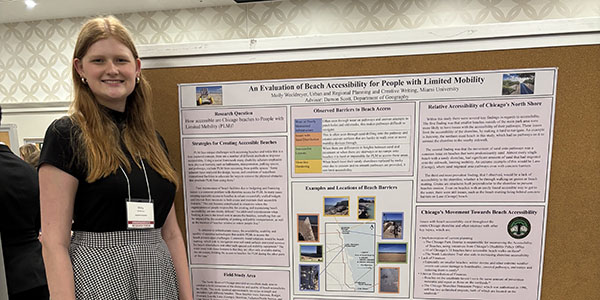Research by undergraduate student addresses Chicago beach accessibility for people with disabilities
Better year-round planning could make Chicago beaches more accessible to people with limited mobility

Research by undergraduate student addresses Chicago beach accessibility for people with disabilities
Chicago beaches need better funding and year-round accessibility planning to better serve people with disabilities, according to research by a Miami University undergraduate student of eight North Shore locations. Combining temporary and permanent accessibility features could help solve part of the problem.
For her research project, “An Evaluation of Beach Accessibility for People with Limited Mobility,” Molly Weeldreyer, a rising senior Urban and Regional Planning and Creative Writing double major, documented accessibility barriers along 10 miles of Chicago’s North Shore. She found that every beach contained two to three major obstacles including worn or poorly maintained infrastructure, sand distribution, inaccessible layouts, and shoreline hardening.
The most pervasive problem was the inability to reach the water’s edge. Even beaches with permanent features like groins — structures built perpendicular to the shoreline to prevent erosion — or temporary features like beach matting — which provide a more stable walking surface on sand — failed to provide clear, accessible routes to the shoreline. Sand drifting onto pathways or the complete absence of pathways created additional barriers for visitors with limited mobility.
Weeldreyer’s research of the beaches revealed poor funding to be the primary cause of these accessibility issues. Some beaches receive more funding than others, and extreme weather events damage boardwalks, pathways, and ramps that cost significant money to repair. Seasonal limitations compound this issue, as temporary features like beach matting and beach wheelchairs are often only available during busy summer months.
“Accessibility is a multifaceted issue. There are a lot of things that go into it, like financing. I found a lot of beaches just didn’t have the financing to implement these accessible features,” Weeldreyer said.
Weeldreyer recommended combining temporary and permanent features year-round as the most effective solution. She also emphasized examining areas surrounding beaches, noting that transportation, parking spaces, and sidewalks all factor into accessibility considerations.
Weeldryer, a member of Miami’s Honors College, took Damon Scott’s, associate professor of Geography and Global and Intercultural Studies, capstone on Contemporary and Urban Planning Debates in Chicago. The goal of the class is for students to learn about contemporary urban planning issues from community leaders, planning professionals and neighborhood organizations. Weeldreyer’s capstone research initially started as a project on erosion, but evolved when she realized she was more interested in addressing how to make spaces more inclusive and accessible for people with disabilities.
“People with disabilities exist everywhere and they deserve to be in all the places that exist. I feel it’s really important to bring awareness to this topic and get people talking about it,” Weeldreyer said. She noted that she found little literature on beach accessibility during her research.